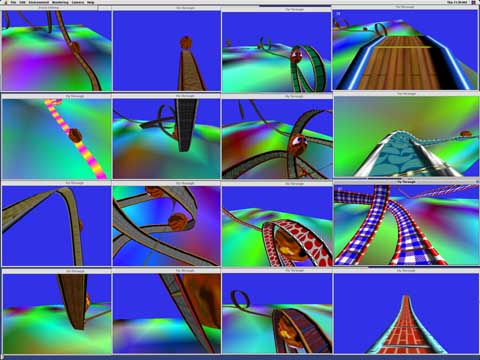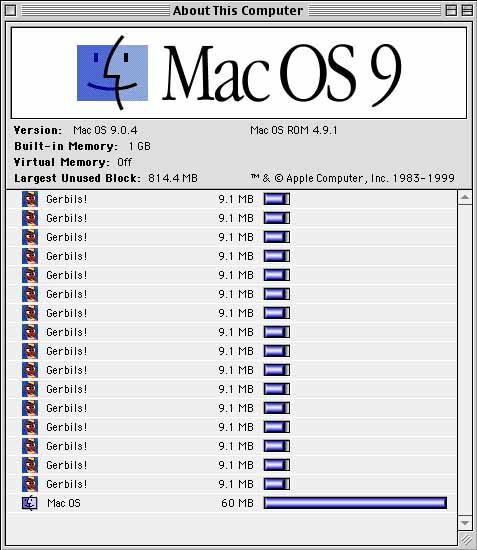High-End Macintosh Benchmarking
© 2000 Washington Apple Pi
Labs
Washington Apple Pi Journal, November/December
2000, pp. 34-35, reprint
information
Long-time fans of Washington Apple Pi Labs (both of them)
will recall that we are fond of using the game
Gerbils! as a benchmark. The game, included with Mac
OS 7.6, was originally designed as a "proof of concept" by
Pangea Software,
(http://www.pangeasoft.net/pangeahistory.html) showing how
QuickDraw 3D could be used in games, and in fact has no
system of scoring, winning, or losing. So maybe it really
isn't a game. And maybe it really isn't a benchmark.
But we like using it, anyway. It has several advantages
over traditional benchmarks:
- like the game, you can't win or lose, since it runs
only on Macintosh computers -- no Wintel or UNIX machines
need apply;
-
- it is a heck of a lot more fun than any other
benchmark we've used;
-
- it is aggressively graphical, allowing even
non-Washington Apple Pi gurus to understand what is going
on. Or at least be equally amused;
-
- the 3D texture mapping in QuickDraw 3D really is
impressive, and you can customize the gerbils, track, and
track surface instead of doing something more
productive;
-
- it annoys the heck out of anyone not directly
involved in the benchmarking.
Clearly, it has at least four more pluses than any other
benchmarking suite available.
So, when a new opportunity came to use our favorite
benchmark, we didn't hesitate. A graphic artist was taking
delivery of a Power Macintosh G4/450 dual-processor machine,
and wanted a full gigabyte (one billion bytes) of memory
added, plus a large flat-screen Sony Trinitron monitor.
Would we like to do the honors?
Mere seconds later, the memory was added, and the
thousand-pound monitor attached. (A large Sony Trinitron is
only slightly smaller and lighter than a Boeing 747
jetliner.) The power button on the G4 was pressed (the new
Apple keyboard doesn't have a power button), the lights
dimmed, and -- nothing happened after Mac OS loaded. Very
boring.
So we immediately transferred a copy of Gerbils!
to the machine, and promptly made 15 copies. Then we
launched all 16 copies at once, and spent several minutes
arranging the windows so we could see them all, plus gave
each a uniquely textured racetrack. Then we took a screen
shot (CMD-Shift-3) or two.
|

|
|
The color image makes a very distracting
background picture (hint, hint). Click on image for
a full-size view.
|
As far as screen shots go, this one is awesome, 1920
pixels by 1440 pixels (26.6 inches by 20 inches), or
2,764,800 pixels. We could never catch gerbils on all 16
screens at once. (OK, maybe we could have, but that would
have been "work," and "work" clearly was not a key
consideration at the time.) We did manage, however, to
immediately attract a crowd...
You see, Gerbils! has one rather unusual
characteristic: if a gerbil bumps into another gerbil on the
track, one falls off. And the one falling off says "Oh-oh!"
in a cute, child-like voice. With just one game active, you
hear "Oh-oh!" fairly often; with sixteen copies active, and
the sound cranked up, you get death treats from those who
claim to be "doing something useful."
We then checked on available memory. With virtual memory
turned off, and all sixteen Gerbils! running at full
blast, we still had 814.4 megabytes of RAM free. Plus, since
Gerbils! isn't multi-processor aware, there was also
an entire unused G4/450 processor, doing nothing useful.
|

|
|
Note that virtual memory is turned off and yet
there are still 814.4 megabytes of RAM free. With
the advent of Mac OS X and "desktop UNIX," this
won't seem that impressive in a year or two, but we
found it amusing, anyway.
|
With great reluctance, we handed the machine over to the
graphic artist.
|



